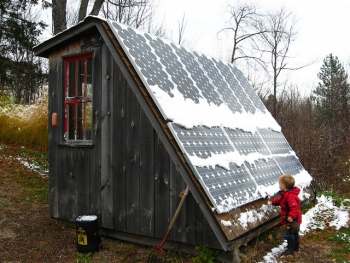What Types of Photovoltaic Cells Are Solar Energy Panels Made of?

There are two basic types of photovoltaic cells used in the production of solar energy panels: crystalline silicon and thin film. According to the Energy Saving Trust (energysavingtrust.org.uk), the three most commonly used solar panels in the UK are monocrystalline, polycrystalline, and hybrid. Hybrid panels are a mix of the more established crystalline silicon cells and the newer thin film cells. Panels made entirely of thin film technology are less popular, but are becoming increasingly better known, and are suitable in some situations where the more rigid crystalline silicon type is not conducive to proper installation.
The Photovoltaic Effect
All solar cells, whether they are made from crystalline silicon or thin film, are photovoltaic cells. These cells work by invoking the photovoltaic effect, the conversion of light into electrical energy. Solar energy panels are collections of photovoltaic cells that gather light from the sun to produce electricity as direct current (DC). Additional equipment--an inverter--converts the direct current to alternating current (AC). This allows individuals to use energy directly collected from the sun to run their televisions, water heaters, blenders, and other electrical appliances.
Crystalline Solar Cells
The most widely used solar energy panels in the UK use crystalline silicon as the semi-conductor material to generate electricity from the sun. These cells are assembled into wafers which are then assembled into panels. These panels come in different sizes and outputs and are mounted to a roof by rails and brackets. With an energy collection efficiency of between 12% and 24%, these crystalline silicon panels provide the most electricity of the three types of solar panels, but are also the heaviest, most difficult to install, and the most expensive.
Crystalline silicon cells come in two types--monocrystalline and polycrystalline. The monocrystalline type often has a higher efficiency than the polycrystalline, while the polycrystalline type (which has a marbled appearance due to its mix of crystals) is usually the cheaper of the two. Monocrystalline cells generally provide one kilowatt per six to eight meter square panel, while polycrystalline cells usually provide one kilowatt per seven to nine meter square panel.
Thin Film Cells
A relatively new technology, thin film solar panels are not generally recognized as having as solid a track record as the crystalline silicon type which has been in use since the 1970s. However, they do appear to be more suitable in some cases, for example, on structures that do not have a flat surface to accommodate the installation of large, rigid crystalline solar panels. Thin film panels are much more flexible and can often be mounted via an adhesive method in instances where the traditional rail and bracket method will not work. Since they have a lower efficiency rating per square meter, more roof space is required for the same level of performance as crystalline panels. In areas where sunlight is more constant and available, roof space may not be an issue.
One disadvantage of the majority of thin film solar panels comes from the materials from which they are made. Where crystalline panels are made from silicon, a recyclable material, most thin film panels on the market include cadmium telluride, a potentially carcinogenic material. Although they do not generally pose a danger when in use, thin film panels are potentially more dangerous to dispose of once they are removed, since the heavy metal cadmium can seep into ground water
Thin film solar panels may grow more popular as they become more available. According to a 2013 article in The Guardian, Ikea stores are slated to add thin film solar panels to UK consumers within the next year.
The Hybrid Solution
Hybrid solar panels are a marriage of monocrystalline photovoltaic cells and thin film technology. The monocrystalline layer goes on the bottom, while the thin film is layered on top. This hybridization addresses several problems that silicon panels and thin film panels alone often present. Having the thin film layer atop the crystalline layer reduces the temperature in the hottest part of the day. High temperatures decrease the effectiveness of crystalline panels. Having the crystalline layer provides the higher and more reliable electricity output that many thin film panels fail to deliver. The thin film layer also alters the somewhat irregular surface of crystalline panels by providing a smoother, less reflective texture to the entire panel, thereby increasing the amount of sunlight collected.
